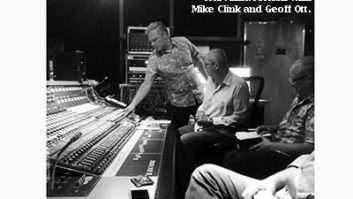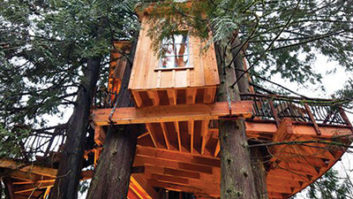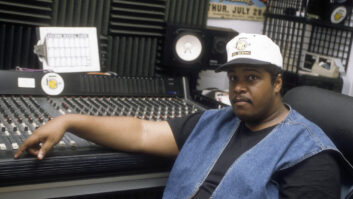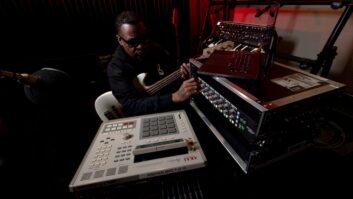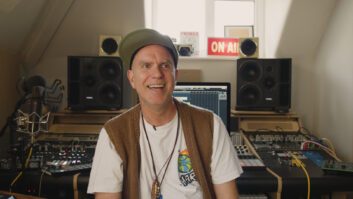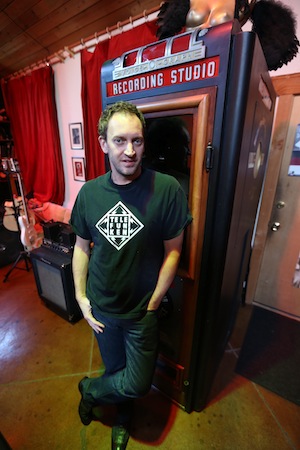
It wasn’t a slam-dunk that Ryan Hadlock—owner of Bear Creek Studio outside of Seattle and producer of high-profile projects by the likes of The Lumineers (their Platinum-selling, Grammy-nominated 2012 debut), The Gossip, Blonde Redhead and Ra Ra Riot—would pursue a career in the music industry. Yes, his father, Joe, a recording engineer, had built Bear Creek in its lovely sylvan horse farm setting in the late ’70s, and young Ryan was a fixture at the place when he was growing up: “I have pictures of me soldering stuff when I was five,” he says with a laugh. “I used to get coffee for people and do various things around the place.”
Still, as his high school years ended, Hadlock determined, “I didn’t want to stick around and hang out with my hippie parents. I didn’t want to be a rock ’n’ roller. I didn’t think it was cool. Originally, I wanted to go into business, so I went to business school, but it didn’t take me that long to decide that was definitely not the world for me,” he laughs. “So I transferred to Evergreen [State], which has a really great music production program and studios with API consoles and all sorts of other good equipment.
“From there, I jumped right into assisting on sessions at Bear Creek—the Afghan Wigs, The Deftones, the Foo Fighters—and I became friends with the guys in the bands, and friends with their friends, and started working on more unsigned bands. I worked my way up into the world of indie rock bands. The indie labels in the mid-’90s were actually easier to deal with than the major labels. The checks came on time, they were really good people, everything was on a handshake, and the music was great. So I kind of climbed the ladder through some touching-post bands—Blackheart Procession, Blonde Redhead—and went on to work with Steven Malkmus, The Gossip, The Strokes, eventually producing bands full time, which is not something my dad had done.”
At the studio’s heart is an enormous, high-ceilinged early 20th century barn that has been exhaustively re-worked through the years to be a state-of-the-art tracking space, with an adjoining control room (“the Wood Room”) stuffed with a Trident TSM console, Neve BCM 10, analog and digital recorders, scads of outboard gear (including plenty of Trident and Neve mic pre’s), a wide selection of top mics by the usual suspects (Neumann, Telefunken, AKG, RCA, Sennheiser, etc.) and all the extra guitars and keyboards any band could want. As a residential studio, Bear Creek offers a variety of accommodations in different spaces on the property, all of them nicely appointed. In short, it’s a wonderful place to both kick back and also to seriously dive in to a project. It’s no wonder they get so much repeat business, and it also explains why Brandi Carlile even named her most recent album Bear Creek.
“I really like getting people together and having that interaction; musicians playing together. That’s the way my dad always worked, too,” Hadlock says. “The indie rock world was all about the art and the performance, and I think that’s one reason I was attracted to it.”
Case in point, The Lumineers. After Hadlock flipped over the group’s demo CD, which a friend had given him at SXSW, “We brought them out to Bear Creek and played them some of the things I’d done and it seemed like a good fit. We had a great time doing it. It was really spontaneous and it went quickly. I think it was two-and-a-half or three weeks of tracking.
“They had drums and acoustic guitar and some ideas for background vocals—‘ho’-ing and ‘hey’-ing and stomping and clapping ideas [as on their smash, “Ho Hey”] they had on their demos. The cellist was new in the band at the time. We spent a lot of time getting the sounds right and the performances, but I think it comes across as a really live-feeling album. I’ll put room mics up and put some distant mics that sound good, but I also want the punch of the close stuff. There was quite a bit of work done on the tracks—editing and comping. I want to have a level of precision, but I don’t necessarily want to show it. I like to be able to craft the song as it goes along.” Hadlock’s go-to engineer for the past two years is Bear Creek’s Jerry Streeter.
The success of The Lumineers has brought a flood of offers Hadlock’s way and he is staying very busy, mostly working with relatively unknown artists (as The Lumineers were!), including Australian singer-songwriter Vance Joy, an indie rock band from Estonia called Ewert & the Two Dragons, Colorado folk group Elephant Revival, the Ontario-based indie/alt-country band The Strumbellas, and others. Would he like to work on The Lumineers second album?
“If it worked out and they wanted to do it, that would be great,” Hadlock says. “But I’m also excited about the possibility of working with the next thing like that; the next thing that’s going to be a wave and make everyone go, ‘Whaaat?’”
